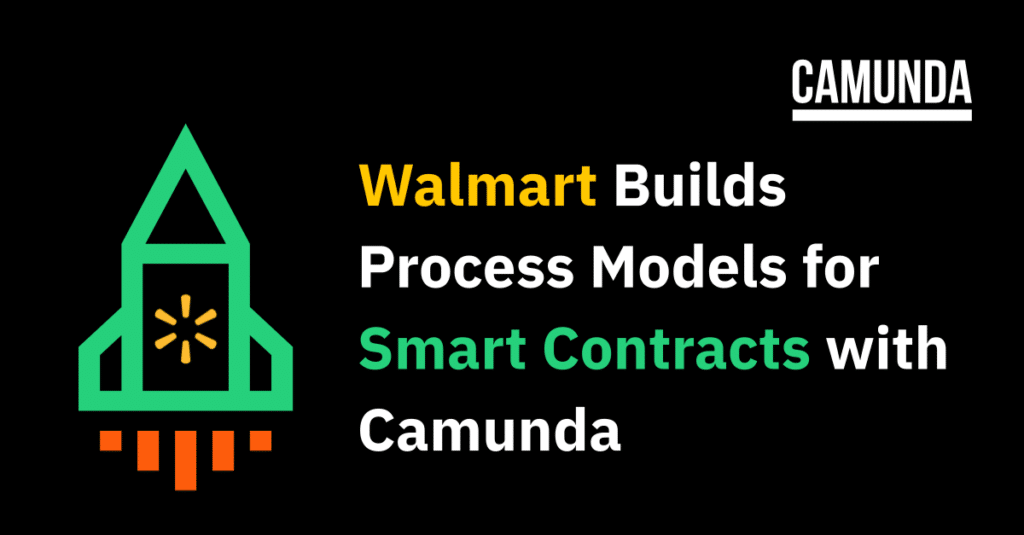At CamundaCon 2023, Sushil Anand, a senior software engineer at Walmart, Inc., and Ayush Seth, a senior manager at Walmart, spoke about how process modeling is helping Walmart provide stakeholder visibility into their smart contracts.
From a business perspective, smart contracts are binding agreements (between, say, Walmart and a vendor in its supply chain) that automatically trigger tasks or functions when certain definitions are met. From a technical perspective, they are essentially lines of code deployed on blockchains. Data in a blockchain cannot be altered or deleted, making it perfect for software that needs to represent a binding agreement.
However, smart contracts can be a problem for some stakeholders, who may not have the specialized programming knowledge necessary to properly structure a smart contract. And the data they contain is usually buried across several different code bases, making visualization into their processes difficult.

Walmart’s challenge has been to decouple the “contract” part from the technology part—in other words, make it possible to create a smart contract based on a few business rules, rather than any specific programming language (such as Solidity or Rust), to ensure maximum usability and facilitate quick changes.
After all, business teams shouldn’t have to know the internal details of the technology used in Walmart’s smart contracts. Rather, they need to be able to:
- Visualize the entire process in one place.
- Analyze the impact of any change without needing to get into the nitty-gritty of the code of a smart contract.
- Quickly introduce and roll out new changes.
- Have templated business contracts at every stage in the process—for backend microservices, frontend channels, and end users.
How it’s implemented and which programming languages are used should be pretty much a black box as far as business teams are concerned. And the process as a whole should be easily changeable from a technology aspect.
As already mentioned, the challenge to achieving this lies in the fact that a smart contract’s data can be scattered across multiple microservices. It can be pretty difficult to have full visibility from end to end. As a result, it can be quite costly to implement process changes.
“When things are done at scale,” Seth said, “at a Walmart scale, it gets really difficult to do any small change.”
The challenge: Achieving end-to-end visibility
Walmart’s solution? A process model for their smart contracts.
Once deployed on the blockchain, smart contracts do what they are programmed to do without any intermediation. A BPMN (business process modeling notation) process works similarly—a sequence of activities triggered by a defined event, it automatically executes as designed.
Enter Camunda. A process orchestration and decision automation platform, Camunda connects the UI that the business teams need in order to visualize Walmart’s smart contracts with the backend technology that defines the contracts. The ability to model the contract isn’t tied to a specific programming language, but rather a simple business process model that can then be transformed into deployable code in any language to any blockchain.
There are a lot of similarities of functions, tasks, and elements (e.g., access control, external calls, conditional, loop, exception handling) between a standard BPMN process and a smart contract. With some additional functionality built on top of Camunda, Walmart can translate the workflow and the logic of a BPM and diagram it into an easily configurable smart contract.
But for any business person working with the smart contract, all that is abstracted. All stakeholders have the same business process and are able to refer to the same visualizations and statuses. Basically, everyone should be on the same page from end to end of the process.
“And that is only possible when we have one point of contact,” Seth said.
Walmart’s proposed architecture for smart contract process modeling UI is divided into three parts:
- The process modeling panel. This is the UI panel where all the business processes can be modeled and persisted. Workflow definitions can be stored and used in the future.
- The contract generation panel. Essentially a BPM-to-smart-contract converter, this panel picks up a business process and exports it as a Solidity file. This converted smart contract can also be stored for future use.
- The contract deployment panel. This panel deploys the smart contract to an Ethereum network or any other blockchain. All of these elements are integrated with APIs, so they can build an end-to-end proper enterprise solution.
To watch a demonstration of this process in action, please view the presentation.
Conclusion
Walmart is leaning on blockchain and Camunda’s process orchestration and decision-automation platform to ensure the company’s core business processes are visible from end to end by every stakeholder. Previously buried in different code bases, processes are being modeled in BPMN, then converted to smart contracts, and deployed on blockchain networks.
As a composable solution, Camunda gives Walmart the flexibility to build on top of it, adding their own features on top of what Camunda provides and their own custom implementations according to their use cases.
“Camunda helps us visualize whatever we need during business implementation,” Seth said. “I would say these were the two biggest reasons we went ahead with Camunda compared to any other solutions out there in the market.”



Start the discussion at forum.camunda.io